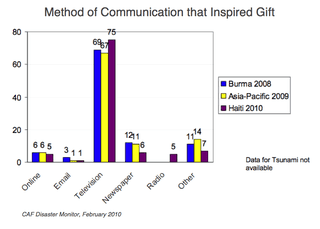How did giving to Haiti compare to previous emergencies?
CAF have recently updated their disaster monitor research which looks at long-term patterns of giving to emergency appeals. All figures are for the UK.
The key findings are:
- Just under half of people surveyed gave to Haiti (in comparison to 81% of people who gave to the 2004 tsunami appeal).
- Women were most generous (51% gave compared to just 44% of men).
- People aged 35-44 were most likely to give (in comparison with those aged 25-34 for the tsunami appeal).
- People in Northern Ireland were most likely to give (those in the North of England were least likely).
Where the research gets interesting is when it analyses what motivated donors and how they actually gave. There has been a fair amount of comment on the importance of social media such as Twitter and Facebook in generating funds and awareness of the disaster. But this research shows the continuing power of traditional media in driving donations – 75% of people interviewed said that reports on TV inspired their gift.
 New media did have an impact. 5% of donors said they gave because of online communications, though email was seen to be surprisingly unimportant, standing at just 1%.
New media did have an impact. 5% of donors said they gave because of online communications, though email was seen to be surprisingly unimportant, standing at just 1%.
It backs up data from Hitwise, which saw the biggest increase in traffic to charity sites coming from news sites. Visits from Facebook and Twitter remained static.
Where new media has demonstrated its importance is in how people actually chose to give. Back in 2004, just 7% of people gave to the tsunami appeal via new media. In 2010, 17% of people surveyed chose this route to support the Haiti appeal.
Donating cash - through traditional collections – remains the most popular route to give. 40% of respondents gave in this way.
Though research shows that social media doesn't appear to be that important, I don't think we are necessarily asking the right questions in research. The impact of a stream of reminders and the power of social compliance can't be ignored.
I'm involved in some meetings next week looking at how we can measure the fundraising impact of group influence generated by online networks. I'll be sure to share what we uncover once the research is complete.
Until then, here's a short and entertaining video showing how powerful it's psychological impact can be (thanks to Social Hallucinations for finding the clip).
For details of what happened in the USA where 13% of donors gave via text, take a look at this post here.
Tags In
The Essentials

Crack the Code to Regular Giving: Insights, Strategies, and a Special Giveaway!

‘Tis Halloween. Keep to the light and beware the Four Fundraisers of the Apocalypse!

Why do people give? The Donor Participation Project with Louis Diez.

A guide to fundraising on the back of a postcard

What does the latest research tell us about the state of fundraising?





